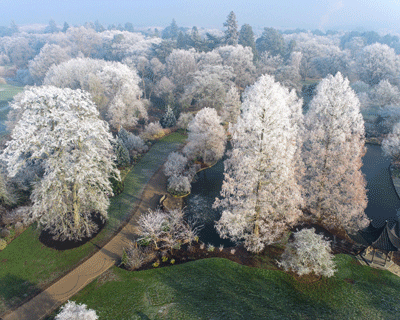RHS winter plant damage survey – findings released
What died, what thrived and other surprises at the five RHS Gardens
Navigating the challenges of gardening in a changing climate is a key research focus for the RHS, and our five Gardens, as well as observations sent in by gardeners at home such as for our Extreme Heat Survey, are proving valuable sources of information on how different plants respond to extreme weather events.
To help the RHS record plant performance in our changing climate, RHS Director of Horticulture, Education & Communities, Tim Upson, has gathered information from across all five RHS Gardens on how plants have coped with this winter's extreme cold. This enables us to identify patterns of what has suffered, what has pulled through, and what copes well with both extremes of temperature that we have seen over the last year.
Much of the damage we've seen after this brutal winter is likely to have resulted from the lack of acclimation. This is the process by which plants adjust to a change in their environment, such as winter cold. This year saw a prolonged wet and mild autumn and an early winter, with a sudden plunge to temperatures well below freezing.This appears to be have been particularly extreme in the south and south east, with RHS Wisley, in Surrey, particularly badly affected. Here there were several consecutive days of sub-zero temperatures, with the garden reaching -10C and perhaps -12C in frost pockets.
The effect of microclimates has also been clear, with plants in known frost pockets most badly affected and often killed outright. Plants in milder microclimates have still suffered, but have seen better survival rates.
A particularly striking trend is the impact on plants grown in containers. It is known from previous studies that container-grown plants are more susceptible to extreme temperatures, and this has certainly played out at the RHS Gardens this winter, with many containerised plants lost while their counterparts planted in the ground have survived.
What was lost
Australian and New Zealand plants such as Hebe, Phormium, Corokia and Pittosporum (the latter two were being trialled as box alternatives) were badly hit across all five sites. Unexpected survivors
In some instances, horticulturists were surprised by some tender plants that appear to have pulled through the extreme cold. Planting location has a big effect on a plant's vulnerability, with microclimates created by features such as walls and surrounding vegetation having a significant effect on the severity of conditions a plant experiences and therefore its chances of survival.
What's thrived through both extremes
Certain plants surprised the horticultural team by triumphing over last summer's extreme heat, and then going on to produce an impressive display even after bitter winter conditions. This has been particularly noticeable for hardy spring-flowering trees and shrubs, which have been unscathed by the winter cold, pulled through last summer's drought and made the most of the heat to promote wood ripening and flower
How to tell if a plant is really dead
Sometimes, a woody plant may not be killed all the way down to the ground, in which case there is hope of regrowth. To check this, gently scrape the





